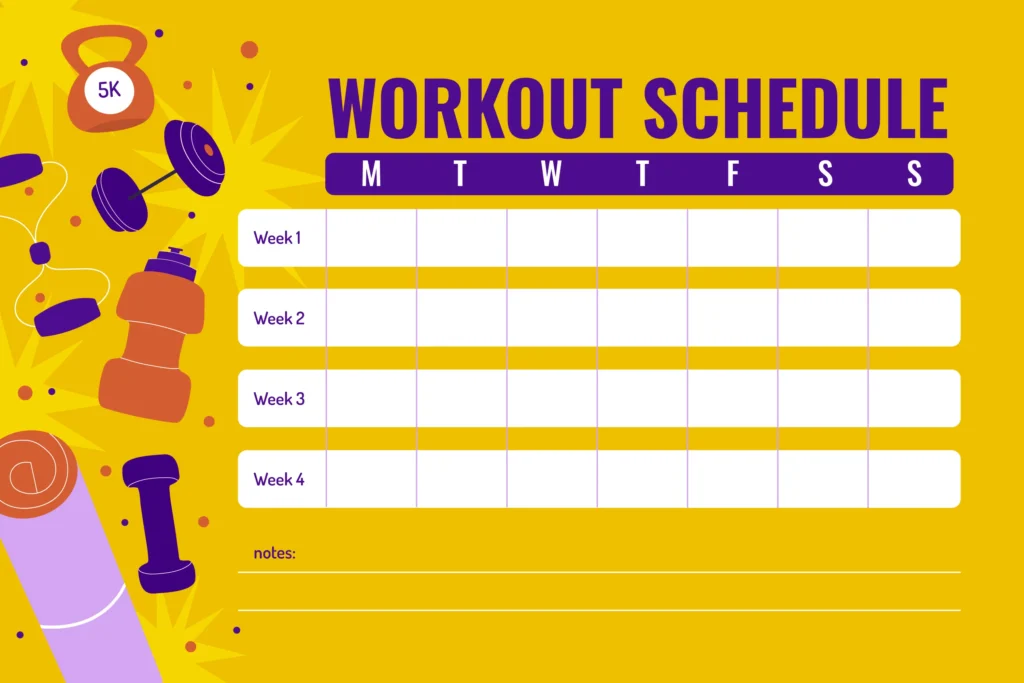Are you tired of inconsistent workout schedules and the struggle to meet your fitness goals? It’s time to take control of your fitness journey with a well-structured workout schedule. In this article, we’ll explore the importance of planning your workouts, the benefits it brings, and how to create an effective schedule that fits seamlessly into your life.
Importance of a Structured Workout Schedule
In the chaos of our daily lives, finding time for workouts can be challenging. A well-thought-out workout schedule not only ensures you make time for exercise but also contributes to the success of your fitness journey. Let’s delve into the benefits and intricacies of effective workout planning.
Benefits of Having a Workout Schedule

Consistency in Training
One of the primary advantages of having a workout schedule is the consistency it brings to your training routine. Consistency is key to achieving any fitness goal, whether it’s weight loss, muscle gain, or overall well-being.
Goal Setting and Achievement
A structured schedule allows you to set specific and achievable fitness goals. Whether you aim to run a marathon, lift heavier weights, or improve flexibility, having a plan in place provides a roadmap to success.
Time Efficiency
Time is a precious commodity, and a well-planned workout schedule ensures you make the most of it. By knowing exactly what exercises to do and when, you can optimize your time in the gym or at home, making your workouts efficient and effective.
How to Create an Effective Workout Schedule

Assessing Fitness Goals
Before diving into planning, it’s crucial to assess your fitness goals. Are you looking to lose weight, build muscle, or enhance endurance? Tailor your schedule to align with your specific objectives.
Choosing Suitable Exercises
Selecting the right exercises is essential for a balanced routine. Include a mix of cardiovascular, strength, and flexibility exercises to address different aspects of fitness.
Incorporating Variety
Boredom is the enemy of consistency. Keep your workouts exciting by incorporating variety. This not only challenges your body but also keeps you mentally engaged.
Balancing Cardio and Strength Training
A well-rounded schedule includes both cardiovascular and strength training exercises. Striking the right balance ensures overall fitness and prevents monotony.
Weekly vs. Monthly Workout Plans

Pros and Cons of Each Approach
Choosing between a weekly or monthly workout plan depends on personal preferences and lifestyle. We’ll explore the advantages and disadvantages of both to help you make an informed decision.
Tailoring Plans to Individual Preferences
Flexibility is key in creating a plan that works for you. Learn how to customize your workout schedule to match your lifestyle and preferences, ensuring long-term adherence.
Morning vs. Evening Workouts
Impact on Energy Levels
The age-old debate: morning or evening workouts? Discover how your body’s energy levels fluctuate throughout the day and find the optimal time for your exercise routine.
Finding the Optimal Time for Personal Preference
While scientific findings provide insights, personal preference plays a significant role. Identify the time that aligns with your natural rhythm and enhances your workout experience.
Incorporating Rest Days

Importance of Rest in the Workout Routine
Rest is often underrated in fitness planning. Understand why rest days are crucial for recovery and how they contribute to improved performance.
Strategies for Active Recovery
Rest doesn’t mean complete inactivity. Explore strategies for active recovery that promote healing and prepare your body for upcoming challenges.
Adapting Workouts to Personal Schedules
Balancing Work and Fitness
Work commitments can pose challenges to regular workouts. Learn tips for balancing work and fitness, ensuring you prioritize your well-being.
Quick Workouts for Busy Days
On hectic days, a quick workout is better than no workout. Discover time-efficient exercises that fit seamlessly into your busiest days.
Tracking Progress

Importance of Monitoring Results
Tracking progress is a motivator and an indicator of success. Explore the significance of monitoring your results and how it enhances your fitness journey.
Utilizing Technology for Tracking
In the digital age, technology offers various tools to track workouts and progress. Find out how apps and wearables can be valuable allies in your fitness quest.
Common Mistakes in Workout Planning
Overtraining
More isn’t always better. Understand the risks of overtraining and how it can hinder rather than help your fitness goals.
Setting Unrealistic Goals
While ambition is commendable, setting unrealistic goals can lead to disappointment. Learn to set achievable milestones that propel you forward.
Ignoring Individual Preferences
Every individual is unique. Ignoring your likes and dislikes in exercise can result in a lack of motivation. Discover how to tailor your plan to suit your preferences.
Staying Motivated
Setting Rewards for Milestones
Celebrate your victories, no matter how small. Setting rewards for reaching milestones keeps you motivated and adds an element of fun to your fitness journey.
Finding Workout Buddies
Exercise is more enjoyable when shared. Find workout buddies to keep each other accountable and

1. How many days a week should I work out?
It depends on your fitness goals and schedule. Generally, 3 to 5 days a week is a good starting point for most people.
2. What if I can’t stick to my workout schedule?
Life happens! If you miss a session, don’t stress. Adjust your schedule and make up for it when possible. Consistency over time is more important.
3. Is it necessary to have rest days?
Absolutely. Rest days are crucial for recovery and preventing burnout. They allow your muscles to repair and grow stronger.
4. How can I overcome a workout plateau?
Plateaus are common. Consider changing your routine, increasing intensity, or consulting a fitness professional for personalized advice.
5. Can I combine cardio and strength training in one session?
Yes, combining both types of exercises in a single session is effective. It saves time and offers a comprehensive workout.






